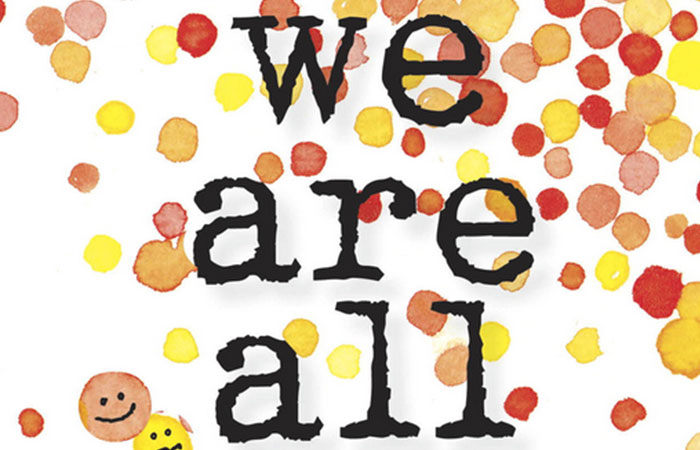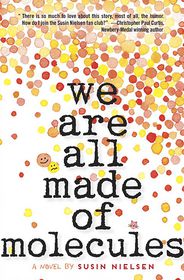Susin Nielsen’s We are All Made of Molecules Explores Blended and Non-Traditional Families

Maybe it’s because of years spent sprawled on the living room rug watching old shows like The Brady Brunch and Step by Step, but I’ve always loved stories of blended and non-traditional families and living situations. There’s the clash of physical belongings (I’m thinking back to Frasier and his father’s iconic duct-taped armchair), personality clashes, and the mixing of different perspectives to create new beginnings and traditions.
We Are All Made of Molecules
We Are All Made of Molecules
Hardcover
$11.44
$16.99
Susin Nielsen’s We are All Made of Molecules is a refreshing look at the blending of two families, a situation which many young people face. It’s equal parts heartwarming and heartbreaking and it’s laugh-out-loud funny. Told through alternating points of view, we get to watch the spectacular mash-up of math and science whiz Stewart and popular it-girl Ashley, who move in together when Stewart’s father and Ashley’s mother decide to take their relationship to the next level.
Each comes with his or her own set of baggage. Some of it is physical (there’s a fantastic scene when Ashley and her mother come home to find a life-sized painting of Stewart’s mother breastfeeding him, newly displayed in the living room) but most of it is emotional.
As Stewart struggles with the death of his mother, still feeling her presence everywhere, through molecules in the air, while trying to prove to himself, in her memory, that he can adjust to the “regular” world, he decides to transfer to the local high school instead of the school of gifted children he has been attending.
Drama queen Ashley reels from her parent’s divorce after her father confesses he is gay. Keeping it secret from her friends, so as not to slip from her firm grip at the top rung of the social ladder, she is hurt and confused, but preoccupied with superficial concerns, like getting an H&M skirt and denying both her father’s and her new not-quite stepbrother’s “freakazoid” existence.
At first, we’re led to believe that, socially, Stewart is a mess while Ashley prances about the school with a legion of followers. And Ashley is pinheaded (her word mix-ups are especially hilarious, wishing she was unconstipated instead of emancipated from her family, bragging of a joie de beaver instead of a joie de vivre) while Stewart is the academically brilliant one.
As the novel progresses, however, we watch these tropes turn on their heads. We learn how fragile Ashley’s friendships really are and we wait, with a certain kind of sad eagerness, for them to fall apart. While Stewart’s intelligence is less tenuous, we witness his ethical and moral judgments grow and break down in complicated ways.
In parallel, Ashley and Stewart navigate school, friendships, bullies, hate crimes, crushes, and the complexities of both their new and “old” families. But it’s when they come together that we understand Stewart’s fascination with atoms and molecules. It is the way we attach to objects and people, the way we invade one another’s physical and emotional lives and absorb a welcome or unwelcome presence, that allows us to change and grow.
Have you read We are All Made of Molecules?
Susin Nielsen’s We are All Made of Molecules is a refreshing look at the blending of two families, a situation which many young people face. It’s equal parts heartwarming and heartbreaking and it’s laugh-out-loud funny. Told through alternating points of view, we get to watch the spectacular mash-up of math and science whiz Stewart and popular it-girl Ashley, who move in together when Stewart’s father and Ashley’s mother decide to take their relationship to the next level.
Each comes with his or her own set of baggage. Some of it is physical (there’s a fantastic scene when Ashley and her mother come home to find a life-sized painting of Stewart’s mother breastfeeding him, newly displayed in the living room) but most of it is emotional.
As Stewart struggles with the death of his mother, still feeling her presence everywhere, through molecules in the air, while trying to prove to himself, in her memory, that he can adjust to the “regular” world, he decides to transfer to the local high school instead of the school of gifted children he has been attending.
Drama queen Ashley reels from her parent’s divorce after her father confesses he is gay. Keeping it secret from her friends, so as not to slip from her firm grip at the top rung of the social ladder, she is hurt and confused, but preoccupied with superficial concerns, like getting an H&M skirt and denying both her father’s and her new not-quite stepbrother’s “freakazoid” existence.
At first, we’re led to believe that, socially, Stewart is a mess while Ashley prances about the school with a legion of followers. And Ashley is pinheaded (her word mix-ups are especially hilarious, wishing she was unconstipated instead of emancipated from her family, bragging of a joie de beaver instead of a joie de vivre) while Stewart is the academically brilliant one.
As the novel progresses, however, we watch these tropes turn on their heads. We learn how fragile Ashley’s friendships really are and we wait, with a certain kind of sad eagerness, for them to fall apart. While Stewart’s intelligence is less tenuous, we witness his ethical and moral judgments grow and break down in complicated ways.
In parallel, Ashley and Stewart navigate school, friendships, bullies, hate crimes, crushes, and the complexities of both their new and “old” families. But it’s when they come together that we understand Stewart’s fascination with atoms and molecules. It is the way we attach to objects and people, the way we invade one another’s physical and emotional lives and absorb a welcome or unwelcome presence, that allows us to change and grow.
Have you read We are All Made of Molecules?
